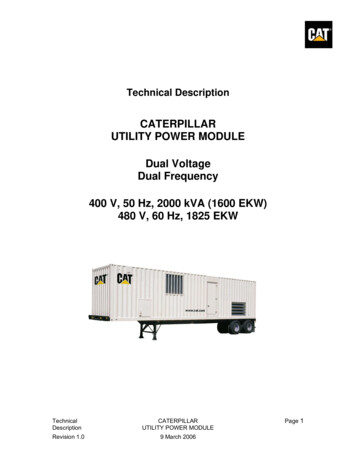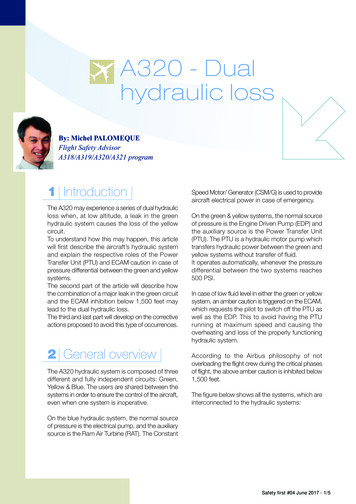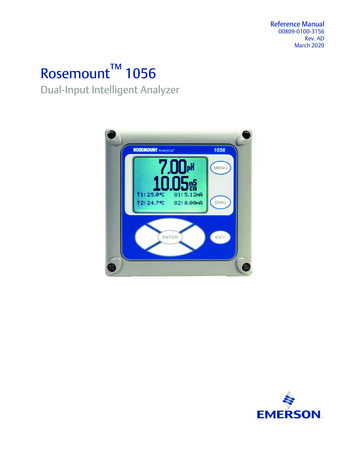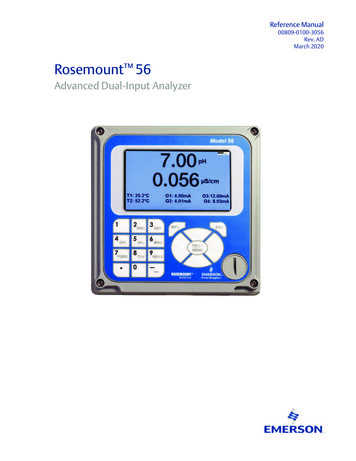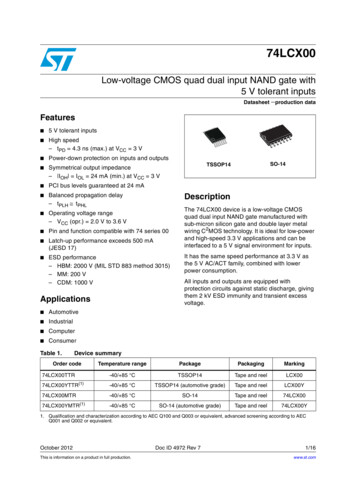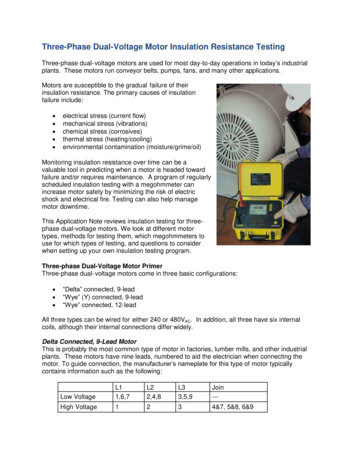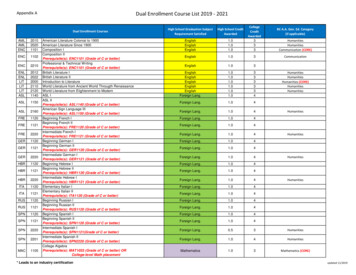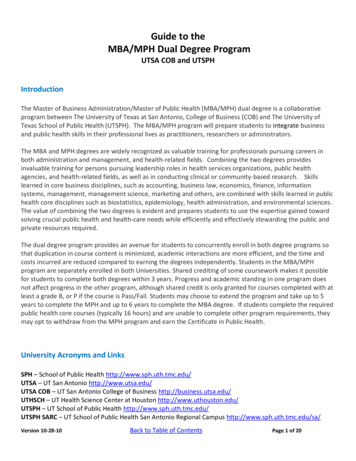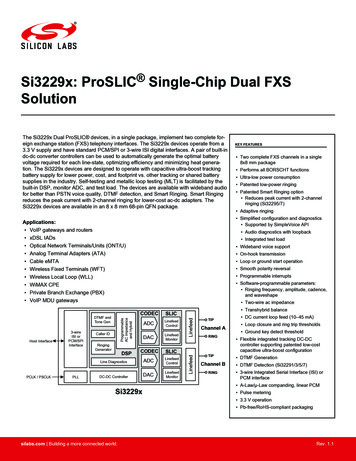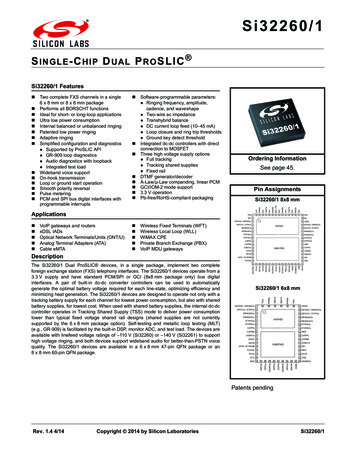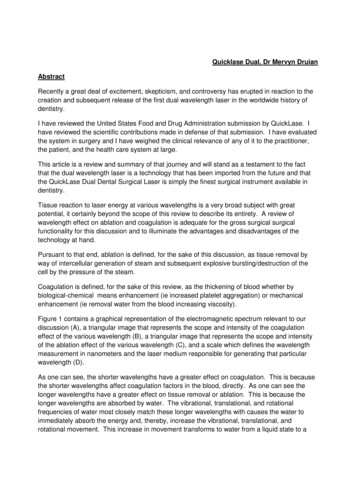
Transcription
Quicklase Dual, Dr Mervyn DruianAbstractRecently a great deal of excitement, skepticism, and controversy has erupted in reaction to thecreation and subsequent release of the first dual wavelength laser in the worldwide history ofdentistry.I have reviewed the United States Food and Drug Administration submission by QuickLase. Ihave reviewed the scientific contributions made in defense of that submission. I have evaluatedthe system in surgery and I have weighed the clinical relevance of any of it to the practitioner,the patient, and the health care system at large.This article is a review and summary of that journey and will stand as a testament to the factthat the dual wavelength laser is a technology that has been imported from the future and thatthe QuickLase Dual Dental Surgical Laser is simply the finest surgical instrument available indentistry.Tissue reaction to laser energy at various wavelengths is a very broad subject with greatpotential, it certainly beyond the scope of this review to describe its entirety. A review ofwavelength effect on ablation and coagulation is adequate for the gross surgical surgicalfunctionality for this discussion and to illuminate the advantages and disadvantages of thetechnology at hand.Pursuant to that end, ablation is defined, for the sake of this discussion, as tissue removal byway of intercellular generation of steam and subsequent explosive bursting/destruction of thecell by the pressure of the steam.Coagulation is defined, for the sake of this review, as the thickening of blood whether bybiological-chemical means enhancement (ie increased platelet aggregation) or mechanicalenhancement (ie removal water from the blood increasing viscosity).Figure 1 contains a graphical representation of the electromagnetic spectrum relevant to ourdiscussion (A), a triangular image that represents the scope and intensity of the coagulationeffect of the various wavelength (B), a triangular image that represents the scope and intensityof the ablation effect of the various wavelength (C), and a scale which defines the wavelengthmeasurement in nanometers and the laser medium responsible for generating that particularwavelength (D).As one can see, the shorter wavelengths have a greater effect on coagulation. This is becausethe shorter wavelengths affect coagulation factors in the blood, directly. As one can see thelonger wavelengths have a greater effect on tissue removal or ablation. This is because thelonger wavelengths are absorbed by water. The vibrational, translational, and rotationalfrequencies of water most closely match these longer wavelengths with causes the water toimmediately absorb the energy and, thereby, increase the vibrational, translational, androtational movement. This increase in movement transforms to water from a liquid state to a
gaseous state (steam) nearly instantaneously. The immediate increase in cellular pressurecaused by the generation of steam ruptures the cell explosively and we have ablation.Please refer to Figure 1. These tissue effects of the wavelengths have been known fordecades. Carbon Dioxide lasers are produce some of the fastest and most complete ablationknown.The 514 nanometer wavelength generated by argon lasers and the 532 nanometer wavelengthgenerated by frequency doubled Nd:YAG lasers produce some of the fastest and mostcomplete photocoagulation witnessed.The Nd:YAG laser at 1064 nanometer is also a very rapid ablator. Because the Nd:YAGproduces 1046 nanometer ablation wavelength and because the a frequency doubling crystalcan change the 1064 nanometer to 532 nanometers, an excellent ablator, the interest insimultaneous dual wavelength surgery was focused on the use of these Nd:YAG lasers andfrequency doubling crystals. Much intellectual, academic discussion and pursuit went into thiscombination. The combination remains of value and anticipated. The problem associated withthis combination is one of price. Such a laser currently would cost tens of thousands of Euros.As one re-examines figure 1 it is noted that two relatively inexpensive and relatively easy topackage alternatives exist; the diode lasers 810 nanometer and 980 nanometer. The lasercompanies have argued that one is better than the other. Of course they always argue the onethey are selling is the superior wavelength, in fact, one company even introduced a thirdwavelength at 950 nanometers claiming that this wavelength was the ‘perfect’ choice as it hasproperties of both 810 nanometer and 980 nanometer.The fact of the matter is that there is only 170 nanometers of wavelength separating thewavelengths at the extreme point and all three of these wavelengths (810, 950 and 980) allhave the ability to coagulate and ablate, therefore, these superiority arguments have alwaysbeen viewed as marketing hype by clinicians and academicians alike.When the QuickLase Dual was invented, patent filed, and then submitted to US FDA forapproval, academicians and clinicians alike, again, viewed the combination of the twowavelengths as straight marketing hype. In fact, the US FDA agreed with the skeptics andrefused to grant clearance until further research documenting the benefit could be produced.The US FDA, in a letter to the company dated November 2, 2007 the FDA stated “In yoursubmission you explain that this device can combine the use of the 810nm wavelength and the980nm wavelength. . There is no predicate that uses two wavelengths simultaneously for thisindication, pleas provide histological data”. In short, the US FDA refused to grant clearanceuntil histological data could be presented to corroborate the claims of efficacy and safety for theindications. The company conducted the study preparing and looking at hundreds of tissuesamples. The study was submitted to the US FDA on December 3, 2007. Upon review of thedata the US FDA immediately granted clearance on December 18, 2007 (K072995). A copy ofthe study is included.
While an in depth examination of the study is encouraged, the results can be fully explained byreviewing Figure 2. The vertical axis represents diameter in millimeters. The horizontal axisrepresents the mixture of wavelengths starting on the left with 0% 810nm and 100% 980 to thefar right of the graph with 100% 810nm and 0% 980nm. The top line of the graph is thecoagulation zone. The middle line is the necrotic zone. The bottom line is the ablationzone.The trend on all three lines is predictable given our understanding of ablation-coagulation andthe effect of wavelength on each. That is to say, refer to the bottom line of figure 2, one wouldexpect that the ablation of pure 980 nanometers would be slightly more effective than theablation effects of pure 810nanometer.However, given the very close proximity of the wavelengths one would not have predicted thatthe ablation effects of pure 980nm would be on the order of 100% better than pure 810nm.Likewise, refer to the top line of Figure 2, one would have predicted a, perhaps, a minordifference in coagulation effect between the two wavelengths but one would have neveranticipated that there would be a difference on the order of 60%.The most astounding finding is that when the wavelengths are mixed, refer to the middle portionof all three lines, that the effects are greatly magnified: a mixture of the two wavelengths providesuperior coagulation and ablation effects as compared to the pure wavelengths alone. Such afinding is unprecedented. Of course many time we see such dramatic differences in publisheddata in vitro and then much to our disappointment we find that the findings do not transpose toin vivo and have little clinical relevance. With the QuickLase Dual this is not the case.
ConclusionI have used the QuickLase in my clinic and I find that the combination of the wavelengths cutsfar more efficiently than any other laser I have used.Furthermore I find that bleeding is less and healing time is quicker. Another very nice feature isthat the manufacturer has provided presets for virtually every imaginable procedure so I neednot look up the correct mix of wavelengths, I simply touch the screen on the desired procedureand the settings are instantaneously loaded for me.The unique design of the fibercaddy allows me to quickly remove the entire fiber and handpiece all together and replace it with a new one if needs be and the fibre is protectedinside the fibrecaddy.The easy design of the Quicklase means I move from surgery to surgery quickly andefficiently.The price of the unit is unbelievable, it is so low that any dentist can afford the finest dental laserever built.Figure 2Graphic Results of StudyDiameter inMillimeters%810nm / %980nm
Histological Evaluation 810nm Vs 980nm WavelengthLaser Radiation on Pig Liver TissueAuthors: Ostler, Calvin D., Kengike, Lisa M., Kengike, MalcolmAbstractThis study addresses the current dental laser surgical industries’ arguments that one ofthe other of two predominate wavelengths in the industry is ‘better’ than the other; thosewavelengths being the 808-810nm and 980nm wavelengths that are produced by the socalled solid state “diode lasers” because the laser energy is actually produced by a laserdiode. While there is clearly a major difference between earlier dental surgical laser,namely the Argon Ion Laser and the Nd:YAG (also the Carbon Dioxide Laser). Themajor performance differences in the earlier laser was clearly because of the differenttissue elements which reacted/absorbed the wavelengths produced by the lasers. TheArgon Ion Laser producing visible blue (457-488nm) and visible green (501-514nm) wasrapidly and readily absorbed by the red hemoglobin in blood. This made the Argon IonLaser a very good coagulation device, but in a relative sense, a poor tissue remover(alabation). The Nd:YAG producing invisible infrared laser energy (1064nm) was notwell absorbed by blood relative to the Argon Ion Laser but was very rapidly absorbed bywater which made it and excellent tissue removal surgical laser. The recent marketingclaims made by the relative manufactures lend the argument to the fact that 810nm iscloser to Argon Ion Laser and would be a better coagulator than tissue remover and thatthe 980nm wavelength is very closer to Nd:YAG and is therefore a better tissueremover. The difference between 514nm (best coagulation wavelength of the Argon IonLaser) and 1064nm produced by the Nd:YAG is 550nm, a large difference. Thedifference in between 810nm and 980nm is a relatively small 170nm. This studyexamines the clinical significance of this difference. The results of this studydemonstrate that the 810nm wavelength nearly doubles the coagulation performance ofthe 980nm wavelength in pig liver. The results of the study further show that the 980wavelength is produces more than double the ablation performance and involves lesstissue overall in pig liver. This study demonstrates that by combining the twowavelengths coagulation and ablation performance can be adjusted and even increasedbeyond the performance of a single wavelength in pig liver. Conclusion: there is aclinical difference in the performance in pig liver. There may be major clinicaladvantages in mixing the wavelengths in surgery and oral tissue treatment.
IntroductionThe ablation, necrotic zone and coagulation zone of the 810nm and 980nm laser,individually, are well defined and well understood. However, the TidalWave DentalDiode Laser will supply both wavelengths simultaneously. Furthermore, the TidalWaveDental Laser will mix user defined amounts of each wavelength. Therefore, this study isdesigned to determine the effects on the ablation zone, necrotic zone, and coagulationzone of pig liver tissue of mixtures of the two wavelengths.The study intent is to evaluate the effects of a varying mixtures of 810nm and 980nmlaser radiation on pig liver. The parameters of interest are the area of ablation, thefringe of necrotic tissue surrounding the area of ablation, and the area of coagulationsurrounding the necrotic fringe (refer to photograph below):The photograph is of a thin section of pig liver that has been exposed to laser radiation.It is presented here to illustrate the regions, zones, fringes, discussed above. For thesake of this study the following definitions of those regions, zones, fringes, areas, etc.
apply. The center circle is the ablation zone. This is the area where the tissue has beablated (or vaporized), the tissue is all but gone. The area between the center circleand the middle circle represents the zone, fringe, or region that is comprised of charred,dead, or necrotic tissue that was not ablated or vaporized by the laser. The areabetween the middle circle and the outer circle represents that area in which the tissue isnot necrotic but the blood in the tissue has coagulated, this is considered thecoagulation region, zone, fringe, area, etc. How each of these regions, zones, fringes,areas, etc. change as the mixture of wavelengths change is the object of this study.Because the depth of cut of laser energy delivered through a cleaved fiber (no clearfocal point as with lens focused lasers) varies not only in power applied but also hugelyvaries in the distance the fiber is held from the tissue and the angle the fiber is held tothe tissue, objective, statistically significant data is all but impossible to obtain. By wayof example, the section above was positioned .5mm from the fiber delivery tip.Identical sections (refer photograph above) exposed to the same radiation for the sameamount of time at a position 1.5mm from the fiber show only minor to moderatecoagulation; no ablation and no necrotic tissue. The center circle shows moderatecoagulation zone while the area between the center circle and the outer circle
represents minor coagulation. As one can clearly see the removal of oral soft tissue bya dentist with a cleaved fiber delivery system is very technique sensitive. The purposeof this study is to not to evaluate various techniques or
Authors: Ostler, Calvin D., Kengike, Lisa M., Kengike, Malcolm Abstract This study addresses the current dental laser surgical industries’ arguments that one of the other of two predominate wavelengths in the industry is ‘better’ than the other; those wavelengths being the 808-810nm and 980nm wavelengths that are produced by the so

